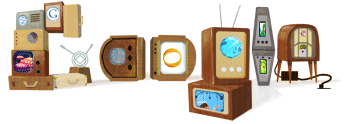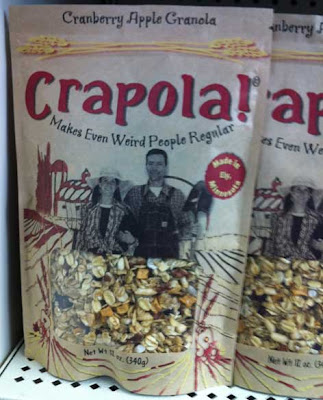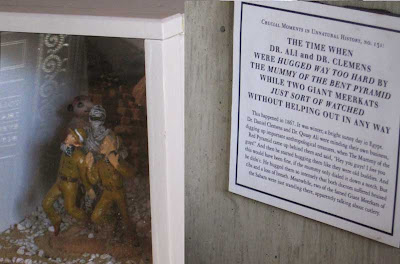 One of the few good things about flying is being trapped with a book for hours at a time. Recently, the book I couldn't escape was Bill Bryson's At Home. It's a rumination on how his home in England, a former rectory, came to be the way it is. And, by extension, how houses and private life in general took the form we know today. (I already wrote a bit about the book when I heard Bryson talk about home lighting, bathing, and servants on MPR.)
One of the few good things about flying is being trapped with a book for hours at a time. Recently, the book I couldn't escape was Bill Bryson's At Home. It's a rumination on how his home in England, a former rectory, came to be the way it is. And, by extension, how houses and private life in general took the form we know today. (I already wrote a bit about the book when I heard Bryson talk about home lighting, bathing, and servants on MPR.)
Bryson's house was built in 1851, and that year recurs as a historical turning point throughout the book, starting with the Crystal Palace in Hyde Park, through the beginning of tea processing in India to the first use of the term "slum" to the introduction of the flush toilet. From the technological to the sociological, the book is one revelation after another. I've been spouting facts from its pages to anyone who'll listen for the past month.
Bryson uses each room of his home to bring up any topic he finds even tangentially related, and the result is amazing. From the book I learned that...
Through the mid-1800s, English clergymen were far from paupers. Rectors like the one who built Bryson's house were paid the equivalent of $400,000 a year in today's dollars in exchange for basically no work. They generally didn't have a sense of religious vocation or do the type of pastoral work we associate with ministers today: they gave one sermon a week, and many of them took the easy option of reading right out of a widely distributed book of sermons. What did they do with their copious amounts of free time? Some of them thought, wrote and invented. Their products include: a dictionary of Icelandic, novels such as Tristram Shandy, the power loom, the Jack Russell terrier breed, gas lighting, the submarine, many plant varieties, and aerial photography from hot air balloons, Not to mention the work from which we derived the term Malthusian and the concept of Bayes' theorem, which was unprovable when it was created but now is used to model climate change, predict the behavior of stock markets, arrive at radiocarbon dates, and for many other tasks that involve probability.
The subject of servants is fascinating. "By 1851, one-third of all the young women in London -- those aged from about fifteen to twenty-five -- were servants. One in three was a prostitute. For many, that was about all the choice there was" (p. 88). And this: "our standard image of servants in black uniforms with frilly caps, starched aprons, and the like actually reflects a fairly short-lived reality. Servants' uniforms didn't become routine until the rise of cotton imports in the 1850s. Before then, the quality of clothes worn by the upper classes was so instantly and visibly superior to that of the working classes that it wasn't necessary to distinguish servants with uniforms" (p. 95). Servants were treated as subhuman, generally, and worked from before the masters rose until after they had gone to bed, every day of the week. Yet this was considered a good job, compared to working in a factory or mine.
Washing clothes was a huge task, and laundry servants in each house had their own concoctions and processes. Bryson notes, "items of clothing made of different types of fabrics -- of velvet and lace, say -- often had to be carefully taken apart, washed separately, and then sewn back together" (p. 107). Laundry had to be done in the home, for the most part, because of the fear of infection, let alone squeamishness about the idea that an upper-class person's clothes might be washed with a lower-class person's.
In my earlier post, I noted Bryson's point that a typical middle class family in the evening would have shared candlelight that was no brighter than the amount of illumination cast by a modern refrigerator. Gas streetlights also were less helpful than you might think: they cast less light than a 25-watt bulb, and were at least 30 yards apart.
Oil lamps were better than candles, but oil sources were expensive. The best was whale oil. As many as 300,000 whales were killed in the 40 years before 1870. Bryson speculates that many, if not all, whale species would have become extinct if kerosene had not been invented. Distilled from coal tar, it soon led other inventors and entrepreneurs to the exploitation of oil (petroleum), which could be distilled into kerosene and gasoline. The latter was thought to be useless, by the way, because it was too combustible.
Indoor gas lamps became common in larger cities after 1820. Unfortunately, the burning gas could make people sick, and "blackened ceilings, discolored fabrics, corroded metal, and left a greasy layer of soot on every horizontal surface" (p. 123). But the lamps were about 20 times as bright as candles. "It is no coincidence that the mid-nineteenth century saw a sudden and lasting boom in newspapers, magazines, books, and sheet music. The number of newspapers and periodicals in Britain leaped from fewer than 150 at the start of the century to almost 5,000 by the end of it." (Changes in typesetting and printing had something to do with that, as well, I'd note.)
The cause of scurvy, vitamin C deficiency, was suspected but not recognized by science until 1939 (!) when a Harvard surgeon withheld the vitamin from his diet until he nearly died. After 19 weeks of malaise, he suddenly "took a turn for the worse -- so much so that he would almost certainly have quickly died had he not been under close medical supervision. He was injected with 1,000 milligrams of vitamin C and was restored to life almost at once" (pp. 167-168). By the way, humans are the only animals (except guinea pigs) that can't synthesize their own vitamin C.
The chapter on the dining room includes fascinating details about the spice trade and the discovery of the New World. About Columbus, Bryson writes, "It would be hard to name any figure in history who has achieved more lasting fame with less competence" (p. 174). Magellan, whom I always thought circumnavigated the globe, actually died before completing the journey; only 18 of his 260 men survived the voyage.
As anyone knows who has read Charles Mann's incredible book 1491, much of the food grown worldwide today came from the native people of the Western Hemisphere; Bryson puts it at 60 percent of all crops (potatoes, tomatoes, and corn, just to name a few). Like many a new technology, "No one foresaw this at the time, however. For the Europeans the irony is that the foods they found they mostly didn't want, while the ones they wanted they didn't find" (p. 176).
The British began drinking tea in the mid-1600s, and could purchase it only from China until the early 1800s because the Chinese managed to keep secret the process of curing the plants. In the 1840s, a Scotsman named Robert Fortune crisscrossed China, pretending to be a native and gathering information on how tea was grown and treated. By saying he was from another part of the country each time (since he spoke no dialect of Chinese), Fortune managed to learn enough to replicate tea processing in India.
Wallpaper was incredibly toxic, especially green wallpaper, which contained arsenic. Bryson speculates this may explain why the chronically ill so often recovered after being moved for a "change of air."
By the early 1800s, the power looms of the Industrial Revolution were poised to vastly expand the production of cloth, particularly cotton, but there was a problem with supplying the raw material, which originally came from India. The American South was perfect for growing cotton, but "the only variety that would grow well in most southern soils was a difficult type known as short staple cotton. This was impossible to harvest profitably because each boll was packed with sticky seeds -- three pounds of them for every pound of cotton fiber -- and these had to be hand-plucked one by one… even with slave labor it could not be done economically" (pp. 394-395). And this is where Eli Whitney and his cotton gin come in, of course. "Before cotton, slavery had been in decline in the United States" but the cotton gin made slavery economically viable. The vast influx of raw material increased production so much that there weren't enough adult mill workers, and so it also led the English mill owners to hire children. Thanks, Eli!
____
I've probably already tried to include too much here... there's no substitute for reading this phenomenal book yourself. (I didn't even mention the parts about cement, the telephone or the mousetrap.)
But I can't end without saying that Bryson points out that comfort as we now think of it was an unknown concept until almost 1800. It wasn't something you experienced yourself, but instead something you gave to someone else. Comfortable was first used in its modern sense in 1780, but by the early 1800s, it had become common to talk about a comfortable home or a comfortable living.
By then, everyone wanted comfort, but Bryson makes it clear that not many had it. The richest people ever were the U.S. financial moguls, such as the Rockefellers, Morgans, Astors, Carnegies and Vanderbilts, who had their heyday around 1900. Adjusted for inflation, they had more money than anyone today (and paid no income tax, to boot). But I am endlessly fascinated that they were no more comfortable (and in many ways were less comfortable) than many middle-class Americans today. They may have worn fur and eaten caviar, but they were hot in the summer, cold in the winter, and they had bad toilet paper.
To make so many of ourselves so comfortable, we've been using energy at an incredible rate. Bryson notes, "Of the total energy produced on Earth since the Industrial Revolution began, half has been consumed in just the last twenty years. Disproportionately, it was consumed by us in the rich world; we are an exceedingly privileged fraction" (p. 451).
Clearly, things cannot last as they are without major breakthroughs in clean energy production, combined with a willingness to give up some of our comforts. But as I flew across the country with Bill Bryson and his descriptions of what life was like before the invention of modern private life, I scribbled onto the title page of the book:
I'd be willing to give up cars, planes, and the long-distance trucking of food if we can just keep electric lighting, gas heat, running water and sewage.


















































